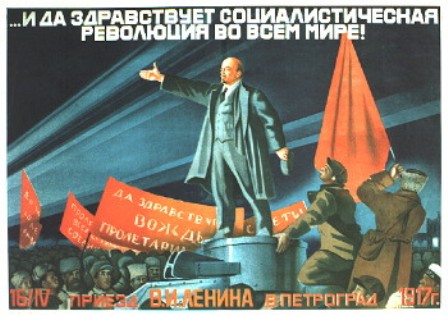|
Within a short period of time, from October 1917 to February 1918,
the Bolsheviks consolidated their control over the greater part of the
territory of the former Russian Empire. One of the chief reasons for
this, to use Lenin锟絪 phrase, the 锟絫riumphal march of the Soviet power锟?
across the country, was, undoubtedly, the mass support of the first
Soviet decrees. Their general democratic character met centuries-old
expectations of the majority of the Russian population. |

In the conditions of an economic dislocation and
unpopular war a radical program of rapid and sweeping reforms
appealed to many social groups. The Decree on Land sanctioned the
transfer of the gentry锟絪 land to the peasants, ensuring the loyalty
of rural communities. The Decree on Peace gave hope of a speedy end
to the war with Germany to the demoralized and exhausted army. The
锟紻eclaration of the Rights of the Peoples of Russia锟?promised
equality, sovereignty, and the right to free self-determination to
all nationality groups and facilitated the acceptance of Soviet
power on the multiethnic fringes of the empire.
The
political system that the Bolsheviks were forging in the months
following the October takeover was distinctly different from the
original idealistic blueprints of a 锟絧roletarian dictatorship.锟?
Before taking control of Russia, Lenin had spoken of doing away with
the punitive machinery of state and replacing it by 锟絛irect arming
of all the people.锟?The population would be armed to defend the
country from any external threat, while the resistance of the former
propertied classes inside would be overcome with the help of the
organs of popular democracy, such as soviets and people锟絪 militia.
However, the brutal logic of holding on to power compelled the
Bolsheviks to establish their own secret police, the All-Russian
Extraordinary Commission for the Struggle against Counterrevolution,
Sabotage, and Speculation (better known by its Russian acronym Cheka).
Set up in December 1917 under the leadership of Felix Dzerzhinsky, Cheka was granted wide powers from arrest and investigation to
passing and executing sentences. Its arsenal of repressive measures
also included property confiscation, withdrawal of food coupons,
blacklisting individuals as 锟絜nemies of the people,锟?and expelling
people from the country into external exile. Cheka evolved into a
formidable instrument of the 锟絧roletarian dictatorship,锟?suppressing
resistance not only of the Bolsheviks锟?natural enemies, such as the
propertied classes, but also of their former allies, including
moderate socialists and anarchists.
Moreover, the new regime soon realized that it would not survive
without a modern army to defend the new state. In January 1918 the
Bolshevik government announced the formation of the Workers and
Peasants锟?Red Army to be recruited on a voluntary basis. In a short
period of time a network of military commissariats was set up in
localities, and, by May 1918, the Red Army was expanded into a
formidable 300,000 strong military force.
Lenin锟絪 concept of the dictatorship of the proletariat left no place
for other political parties in the new state system. It accorded the
Russian Communist Party of Bolsheviks (as it became officially
called in March 1918) the role of the core of the proletarian
dictatorship. The party directed activities of all governmental and
nongovernmental organizations. It tolerated other socialist
groupings only if they recognized the legitimacy of Soviet power and
the supremacy of the Bolsheviks as the ruling party. In practice,
this led inevitably to the emergence and rapid consolidation of a
one-party system.